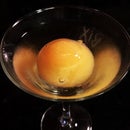Introduction: Figure Eight Motion Drive
Back in the 90s I was very interested in Micro Aerial Vehicles (MAVs).
I researched hummingbirds and bumblebees in hover flight and discovered their wings flapped in a figure eight motion. This motion is similar to how you would move your arms and hands when trying to stay afloat in water.
So I researched all kinds of mechanisms and designs that could provide this motion and was surprised with the complexity of every system.
I decided to figure out my own mechanism and started running simulations using a kinematic dynamic software package called Mechanica Motion. NOTE: Mechanica is now ProEngineer which can be found at http://www.ptc.com/products/proengineer/mechanism-dynamics
For my first simulation i was thinking that a figure eight looks like two circles touching each other. Based on that i created a two gear system with two connecting rods. I arranged the gears to first provide a circle as they both spun at the same speed. I then thought if I spun one of the gears twice as fast as the other i should see two perfect lobes. Well i didn't. I got something close to a lopsided figure eight with one side having a convex shape. So i played with phasing of the gears and still no perfect figure eight. A colleague of mine happened to be visiting and asked me to spin the two gears at the same speed. I told her i already tried that and proceeded to show her. It was a truly eureka moment as the mechanism traced a really small figure 8! It was all in the phasing.
So after a few optimizations the perfect figure eight motion was accomplished with 4 basic parts, ie 2 counter rotating gears coupled with two connecting arms.
I was so excited, applied for a patent and two years later the US Patent & Trademark Office gave me the saddest news of my life. The mechanism had already been patented ( #2,775,899 ) in 1957 by C.L. Vagneur .
During the anxious two years i researched features like adding a second pair of connecting rods to flip the "wing" during the figure eight motion.
I looked at other applications like rowing & bike pedaling mechanisms, hair braiding, ceiling fans, wind energy device, etc . I researched the web on all things figure eight and found it was a common motion for polishing, cleaning and mixing.
Anyway, after discovering Instructables I thought it would be great to share all this info for anyone looking for that perfect figure eight motion drive!
Sabri Sansoy
The steps are more of slide presentation.
Step 1: Frame by Frame Trace
Frame by Frame analysis showing how the point where the two connecting rods are connected traces the figure 8. The two gears must counterrotate at the same speed.
Step 2: Front View Diagram
Each connecting arm must be attached at the outer rim of each gear (points C & D) and then attached to each other at pont P
l = length of connector arm which should equal twice the radius of the gear
r = radius of circle
x = distance from origin
Step 3: Motion Graphs
The top left graph shows the Horizontal Position vs Time of point P in the previous slide.
The top right graph shows the Vertical Position vs Time.
The bottom left graph shows the Velocity Magnitude vs Time.
The bottom right graph shows the Acceleration Magitude vs Time
Step 4: Predicted Motion Vs Empirical Results
NOTE: This is not an Apples to Apples comparison.
The right side graph depicts real measurements taken from high speed photography of a fly or bee in forward motion. (Reference to follow)
The left side of the graph shows the velocity of point P for the various positions along the figure 8.
Just what was interesting was how the two patterns are somewhat similar.
Step 5: Reduced to Practice
Using a Lego robotics kit it was really easy to assemble a working prototype.
Step 6: Variations on a Theme - Smaller Eight
x is greater than r
l equal to twice x
Step 7: Variations on a Theme - Droopy Eight
l is greater than twice x
x is greater than r
Step 8: Variations on a Theme - Smiley Eight
x is greater than r
l is less than twice x
Step 9: Variations on a Theme - Lopsided Eight
The length of connecting arm l1 is longer than connecting arm l2.
Step 10: Drive Shaft Configuration
As long as the phasing between the two counter rotating arms can be maintained any variation of the mechanism can work, depending on the loads, natural frequecies, etc. of course :)
Step 11: Making the Wing Flip
Hummingbirds and bumble bees flip their wings during the back and forth motion.
Part of the challenge was to figure out how to do this with my figure eight mechanism.
After some thought and analysis, the solution was to add a second pair of connecting arms (8 & 9) right behind the primary set of arms (6 & 7).
Point 10 represents the leading edge of the wing and point 11 represents the trailing edge of the wing.
When i first modeled this in the simulation package the mechanism locked up.
After further investigation it was discovered that the distance between 10 and 11 vary thru the course of the figure 8 motion.
So the fix is to put some sort of slider joint between the two.
What's not shown here is the side view that shows the second pair of connecting arms are offset ,ie sit on top of, from the first set of connecting arms. The two pairs of arms would collide otherwise.
Step 12: Micro Aerial Vehicle
Here's one concept for a micro aerial vehicle. This more closely represents how a hummingbird or bumblebee would fly. Another option not shown here is to attach the wings directly to the drive, in other words points 2 would be attached at the connector arms and not the frame 3.
Step 13: Animations
Figure Eight Motion Drive Demonstration - Bike Pedaling
Figure Eight Motion Drive Demonstration - Bike Pedaling with Legs
Figure Eight Motion Drive Demonstration - Horizontal Mixer
Figure Eight Motion Drive Demonstration - Horizontal Mixer
Figure Eight Motion Drive Demonstration - Sculler













